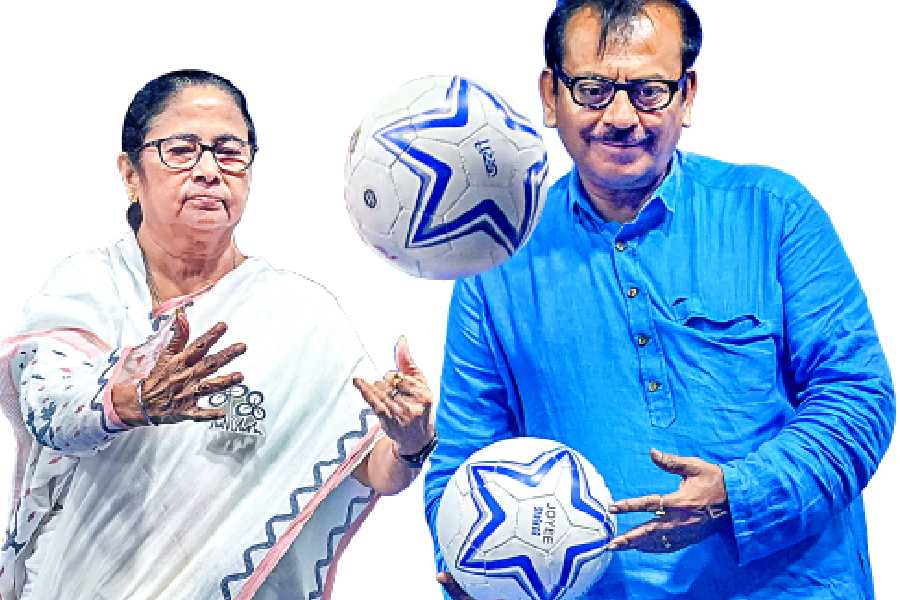Rohan's parents were surprised when they found the otherwise exuberant boy hiding in the bathroom when it was time for him to leave for school. Then, after some days, he was so full of beans again that the teachers complained of mischievous behaviour. Some weeks later, the boy was once again hiding behind closed doors. The cycle continued till one day, after he cursed his teacher, his worried parents took him to a doctor.
The five-year-old boy's mood swings were diagnosed as juvenile bipolar disorder (BPD).
BPD, most people would think, is an adult mental illness. But health experts say that it can affect children too. And it's just one of the many mental disorders generally associated with adults that are now being seen in children.
Explosive moods, irrational fears, manic happiness or inexplicable tears are no longer adult emotions. A range of adult mental illnesses — from anxiety and depression to psychoses, panic disorders and obsessive compulsive disorders — are showing up in children.
A recent study by the National Institute of Mental Health and Neurosciences (Nimhans) in Bangalore found that 12.5 per cent of the 2,064 children it surveyed suffered from adolescent psychiatric disorders. While the Nimhans study assessed minors from newborns to 16-year-olds, a study of children between 4 and 11 years of age by the Postgraduate Institute of Medical Education and Research (PGIMER) in Chandigarh revealed that 6.3 per cent of them suffered from psychiatric disorders.
'As compared to the West, the prevalence is low in India because of under-reporting of cases and protective factors such as family and social support, lifestyle and better coping mechanisms,' says Sekhar Seshadri, professor of psychiatry, Nimhans. 'But it's high time we understand that children and adolescents are vulnerable to psychiatric disorders like adults.'
Experts also fear that more and more children are getting affected by mental illnesses. 'An examination of a series of studies further revealed the prevalence of psychiatric disorders in children and adolescents rose from 9.4 per cent in 1967 to 16.5 per cent in 2007,' Dr Seshadri says.
Until recently, it was generally thought small children were vulnerable to psychological conditions such as defiance, aggression, attention deficits and autism. But disorders such as depression, psychosis (acute fear), anxiety, BPD and schizophrenia were seemingly restricted to adults.
'Even a couple of decades ago, we believed that children were not capable of getting these disorders. But new studies are showing these conditions — woven in our genes — can start to express themselves much earlier than we thought,' says Savita Malhotra, head, department of psychiatry, PGIMER. 'Besides, many of the mental disorders we see in adulthood have antecedents in childhood,' she says.
Seshadri explains that a child may be vulnerable to a certain disorder, but it can get aggravated by environmental factors or stress.
All of us, in other words, are susceptible to many of the illnesses which can be triggered early by trauma or stress. 'With the unravelling of the human genome project we now know that both nature (genes) and nurture (environment) play a role in the early onset of these disorders,' says Monojit Debnath, an expert in psychiatric genomics at Nimhans. He says that there are several genes waiting to be triggered and manifested as mental illnesses.
The early triggers or risk factors — such as infection, toxins and injuries — can affect the developing brain when the child is in the mother's womb. This, Debnath says, is called the first hit. The second hit has to do with the pressures that the child faces from parents, teachers, peer groups and so on.
'Nowadays the brain is hit hard on both occasions — by environmental toxins and complex microbial infections before birth and by pressures at home and school after birth,' he says. It is this double damage that leads a genetic vulnerability to become a full-blown ailment.
The second hit is often parental. Take the case of Rukmini (name changed), a nine-year-old girl who hates school. It took her more than two months to adjust to kindergarten when she was three. Even now, she refuses to go to school after every vacation, complaining of a pain in the stomach or the chest. Psychiatrist Jai Ranjan Ram found that her father — a manager in a multinational bank — was a hyper-anxious man. Though caring, he made the child miserable because of his fastidious ways. And the child, the psychiatrist found, suffered from an anxiety disorder.
The consultant psychiatrist at Apollo Gleneagles Hospital, Calcutta, holds that an extremely competitive environment in school and pressures at home — breaking up of nuclear families, urbanisation, changing lifestyles and depleting social supports — may force certain genes to express themselves earlier than expected.
Yet it is difficult to diagnose juvenile BPD as many of its symptoms overlap with attention deficit disorder, a common childhood psychiatric condition. 'The dilemma often leads to a late diagnosis which may eventually prove to be a grave medical error,' Ram says.
It's not easy for parents to spot the symptoms either. Rima Mukherjee, another Calcutta-based consultant psychiatrist, frequently comes across cases of juvenile psychiatric disorders, and observes parental confusion.
Is the child obsessive or just fastidious? Depressed or ruminative? High-spirited or manic? Parents find it difficult to read the symptoms, and are often in a state of denial. 'They are unwilling to accept that their kids have a mental illness. 'What depression, we get everything for his or her needs' is the typical reaction,' Mukherjee says.
The Nimhans study found only 37.5 per cent of parents of children with mental health disorders perceived that the child had a problem and needed treatment. 'The stigma against mental illness or just ignorance prevents many parents from seeking expert help,' adds Zena Deb, a clinical psychologist at Mon Psychiatric Nursing Home, Calcutta.
The experts stress that pressures on children are growing by leaps and bounds. From admission to school to colleges — every step is seen as a question of life or death. Even at play, there is enormous pressure on children to excel.
'Parents who hover over and intrude into their children's play are a big part of the problem. Free play — unsupervised by a trainer or a parent — helps students build bonds with peers and learn to control emotions that arise from stress. They learn how to make decisions, solve problems, exert self control and follow rules,' says Prasanta Kumar Ray, social psychologist, Institute of Psychiatry, Calcutta.
School administrators confess there is little that they can do in such cases. 'We organise sessions with parents to help them identify problems,' says Anjana Saha, principal, Mahadevi Birla Academy, Calcutta. Some students are sent to counsellors or therapists.
What then is the way out? Salony Priya, a counselling psychologist and school consultant, believes both teachers and parents need to be sensitised about children's emotional needs. And Deb stresses that there has to be greater interaction between parents and children.
Often parents come back home extremely stressed out after a hard day's work and can spare little 'quality' time for their children. 'The children feel they are insignificant and the isolation shows up as conduct disorder and eventually culminates in severe depression,' says Ray of the Institute of Psychiatry, Calcutta.
Ram noted the distancing within families at a restaurant one evening. A family was sitting at a table next to him, and each member — the parents and their young son and daughter — held a smartphone. And all through the meal, they fidgeted with their phones.
'They hardly spoke a few words with each other,' says Ram. 'This is how most family members interact even at home.'
Ram rues that many of the adolescents he treats would rather open up to a stranger on social media sites such as Facebook than their parents when faced with trouble. 'They get disconnected from the real world,' he says.
These changes are not unexpected in a society that's been becoming individualistic from a collective one, Ray says. In traditional societies, on the other hand, such cases are still rare. A survey of 25 villages in the Himalayas found that mental disorder was rare there, says Ray, who often visits pastoral communities in the hills for research. There was no case of suicide, for instance, in the last 10 years.
'I don't suggest that parents adopt a pastoral life, but they have to be more resilient,' he says.
The first step is to understand that each child has a specific temperament and potential. 'All caregivers — teachers and guardians — must realise this and identify the child's unique features,' says Malhotra. 'Let them be themselves.'
Look Out!
Depression
Danger signs: Loss of appetite and energy, irritability, feelings of worthlessness, suicidal thoughts
Treatment: Cognitive therapy; drugs, as an adjunct to treatment
General Anxiety Disorder
Danger signs: Children older than 5 years cling to parents, are unable to function in social settings or are completely withdrawn
Treatment: Cognitive therapy; acceptance and commitment therapy, which teaches children to tolerate discomfort
Obsessive Compulsive Disorder
Danger signs: When obsessive habits begin to interfere with a child's normal activities
Treatment: Behavioural therapies like response prevention. Drugs are the last resort
Bipolar Disorder
Danger signs: Short temper, incoherent speech, inability to focus; loss of appetite, energy may signal the depressive phase; look for cycles of the two phases
Treatment: Talk therapy with family; drugs (mood stabilisers, antipsychotics) can be used.











